
This article is written in partnership with Mountain West Veterinary Specialists.
If you’ve spent a year in Salt Lake City, the thought of Salt Lake City’s inversion probably makes you groan and even worry a little.
Utah’s inversion is caused by air pollutants getting stuck in the valley along the Wasatch Front due to a switch in the normal temperatures of the atmosphere. Normally warmer air is on the bottom and colder air is on top, when this flips, an inversion happens. The warm air on top acts like a lid holding in air pollutants.
We know (and are still learning of) the damage bad air can cause to human bodies, but new studies are coming out showing that it can also impact the health of our pets.
The air quality really impacts how much time we want to or should spend outside, so keep in mind if you don’t want to be out in the bad air, your dog probably shouldn’t be out there either.
Air Quality In Utah
Utah’s air quality is monitored by the Utah Department of Environmental Quality (DEQ). You can find daily air quality information for your area here. Before we dive a little deeper into how air quality is measured and what certain things mean, we will start simple.
There are six color-coded rankings for air quality, listed below from good to bad.
- Green- good
- Yellow- moderate
- Orange- unhealthy for sensitive groups
- Red- unhealthy
- Purple- very unhealthy
- Maroon- hazardous
Many weather apps use this same ranking system so it’s pretty simple to do a quick air check before heading out to play with your dog. Google maps also recently released an air quality map in the layers!
Utah’s air quality is measured and reported in PM (particulate matter), which is known as particle pollution. The lower PM, the better the air quality. Ozone is another form of air pollution and is measured in PPM (parts per million), again, lower is better. Combine these two and you have AQI (air quality index), which is reported using the color-coded system above.

During times of inversion, air quality deteriorates quickly. In Salt Lake City, inversions are common from November to February.
How Utah’s Inversion Can Affect Your Dog
When you stop and think about it, it makes sense that the air quality doesn’t only affect us but our dogs as well. Some studies have come out recently showing the impact of air pollutants on our furry loved ones.
Our friends at Mountain West Veterinary Specialists gave us some information when it comes to your dog and the air quality.
“Pets are exposed to a variety of pollutants, exhaust from cars and trucks, coal, construction, factory emissions as well as pollutants in the home like tobacco or vape smoke, cooking fumes or wood-burning fireplaces. A recent study in Mexico revealed that dogs exposed to poor air quality develop brain changes similar to changes in the brain of Alzheimer’s patients.”
Air quality can also impact your dog’s respiratory system causing coughing and breathing problems. Similar to humans, we aren’t sure of ALL the possible effects bad air could have on us and our pets, but we do know it’s important we can do everything we can to avoid those issues.
Activity recommendations based on the air quality chart are the same for both humans and dogs.
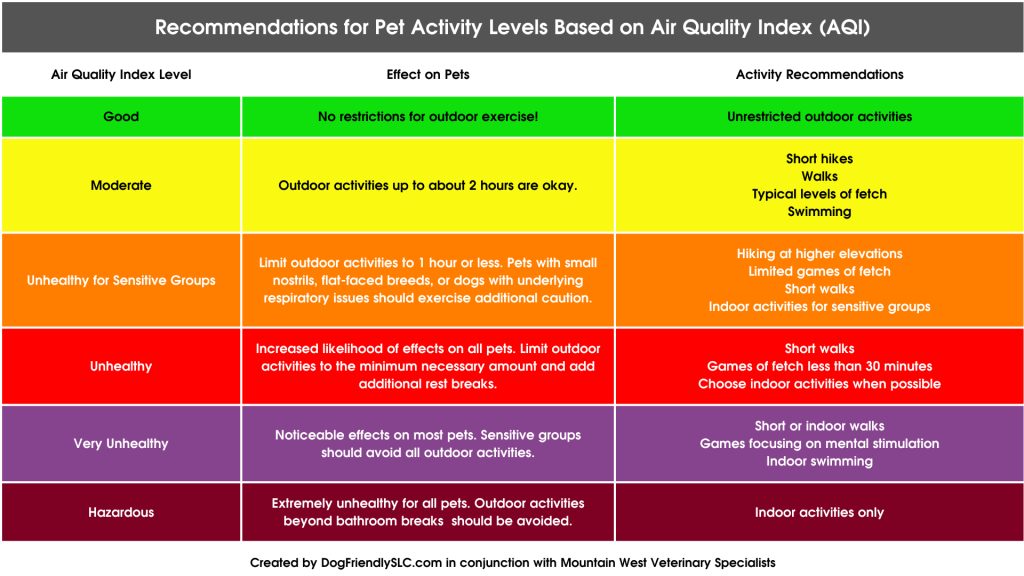
Keeping Your Dog Safe On Bad Air Days
It’s important to avoid outdoor exercise on poor air quality days by paying attention to the air quality forecast and opting for indoor activities on any days worse than yellow. You may even want to be more strict on staying indoors if your dog is in a sensitive group, like brachycephalic (flat-faced) dogs and dogs with existing respiratory problems such as asthma, collapsing trachea, etc.
The great news is that Salt Lake City has some wonderful options for indoor activities for you and your pet – like taking an indoor walk at City Creek or Scheels. Salt Lake City also has three indoor dog pools that are great for getting that pent-up energy out. Dog treadmills are also becoming more popular with a few popping up in the Salt Lake Valley.
Another way to avoid the bad air is to get above it! Head out of the Salt Lake Valley and out of the inversion. Opt for higher elevation hikes and parks in places like Park City and the High Uintahs. Here are some options for dog-friendly activities outside of Salt Lake City:
- Park City Dog Parks
- Millcreek Canyon
- Hikes in Park City, Heber or the high Uintas
If you’d rather stay in your home, canine enrichment is a great way you can entertain your pup. There are lots of enrichment toys like snuffle mats and treat dispensing puzzles.

Keeping Your Dog Safe Indoors
You can keep both you and your dog safe by changing your air filters regularly and closing doors and windows during inversions.
Vacuuming and dusting also helps to keep your air clean.
Lastly, consider purchasing an air purifier for your home. Having one where your dog sleeps is a good idea.
Respiratory Symptoms To Watch For On Bad Air Days
According to Mountain West Veterinary Specialists, it’s important to seek care immediately if you notice any of these symptoms in your dog during times of inversion.
- Coughing
- Respirtory difficulty/Increased respitory rate
- Lethargy
- General malaise
For emergency services, don’t hesitate to visit Mountain West’s 24-hour emergency room in Layton.

This post may contain affiliate links which result in Dog Friendly SLC making a small commission. By shopping products we recommend, you ensure that we can keep finding dog friendly places in Salt Lake City and Utah. We appreciate your support!
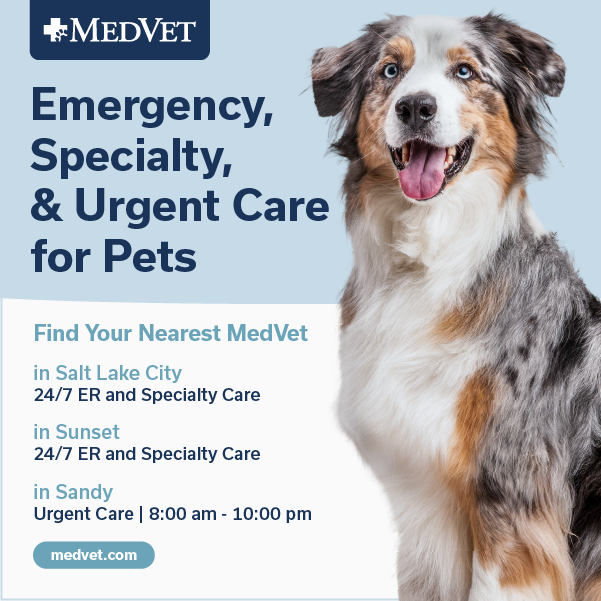


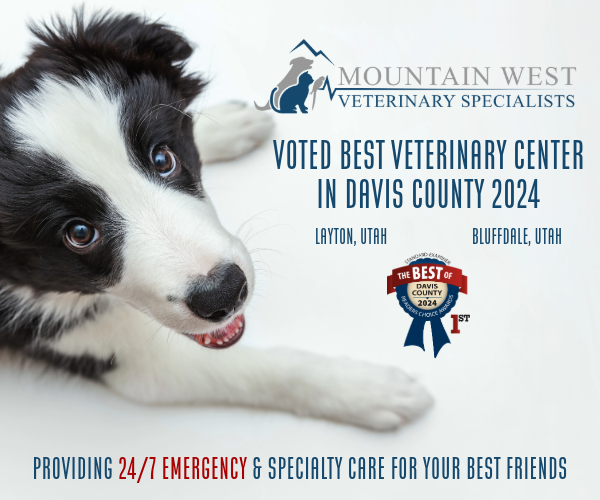


![Aarf_300x250[1]](https://dogfriendlyslc.com/wp-content/uploads/2023/01/Aarf_300x2501.png)
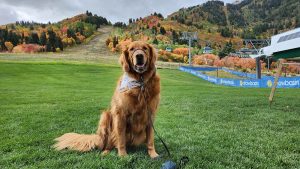

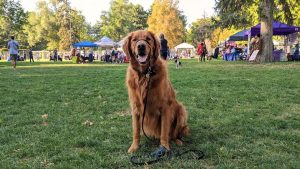


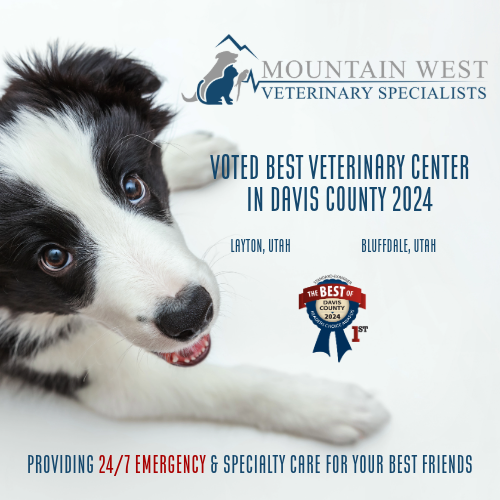






![Aarf_728x90[1]](https://dogfriendlyslc.com/wp-content/uploads/2023/04/Aarf_728x901.png)
